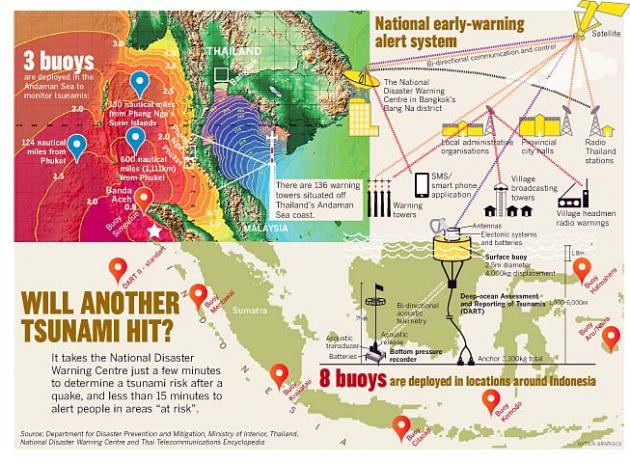Oprettet af deepseadivers d. 29-12-2012 15:19
#1

PHUKET – According to the National Disaster Warning Centre (NDWC), Thailand now has the best warning system in Southeast Asia, eight years after the Andaman coast was ravaged by a devastating tsunami on Boxing Day in 2004.
Before monstrous waves hit Thai shores and killed over 8,000 people in six provinces along the southern coast, no one knew the tsunami was coming.
All that will change with the early alert system and instruments installed by the National Disaster Warning Centre (NDWC) along the Andaman coast over the past eight years, backed by necessary regulations.
Now, ample time for evacuation is assured with streamlined regulations, in a bid to save lives.
The devastating waves killed 5,395 people – many of them foreign tourists – with another 2,817 people swept away or lost. Over 58,550 people were affected, including 1,480 children who lost one or both parents.
“Within two minutes (after tsunami waves start to form), we can now calculate the speed and know exactly when they will reach the shore. Messages could be sent out immediately after the calculation,” Captain Song Ekmahachai, chief of the NDWC’s Disaster Warning and Dissemination Division, told The Nation in an exclusive interview.
He said alerts could be sent to the public within 15 minutes via satellite and warning towers.
To prevent another disaster from an earthquake-driven tsunami, the NDWC has set up 136 warning towers and three tsunami-detection buoys in the Andaman Sea – one near the coast and two others in the deep sea. When an abnormal tidal wave is detected, the buoys send data to the NDWC via satellite, where staff members work around the clock to monitor updates on computer screens. Many will miss the opportunity to celebrate New Year and other festivals.
The centre then double-checks data with the Thai Meteorological Department, the United States Geological Survey (USGS), the World Meteorological Organisation (WMO), and other authorised disaster monitoring agencies to confirm the occurrence.
Upon confirmation, the centre calculates the wave direction and expected arrival time. This can be completed in two minutes, allowing the centre to send out correct warning messages to the public via satellite and warning towers.
Messages will be sent to the media and related agencies via 16 fax machines, eight hotlines, hundreds of radio stations, and dozens of television stations.
The centre has the capacity to send short messages to 90 million mobile phones, but due to budget constraints, it has limited the access to some 15,000 public officials throughout the country.
NDWC director Group Captain Somsak Khaosuwan said the National Broadcasting and Telecommunications Commission (NBTC) will issue a regulation soon that allows the centre to broadcast tsunami warning messages whenever necessary.
“We will no longer need permission from the Television Pool of Thailand or TV station directors. We can interrupt any ongoing television programme,” he said.
A directive will also be issued to designate the NDWC as the only agency responsible for issuing tsunami alerts. All other agencies and experts, including academics, will be barred from giving such alerts, in order to prevent the spreading of wrong information that may cause panic.
“They [would] just speak to the public without responsibility. We are the only ones who have the authority to send out tsunami warning messages,” Somsak said.
Because the 2004 tsunami was caused by a huge quake in the Indian Ocean, near the Andaman Sea, the NDWC will also monitor earthquakes around the world, particularly ones in the Indian Ocean and the Andaman Sea.
Associate Professor Penneung Warnitchai, an earthquake expert at the Asian Institute of Technology, said data over the past few years suggested there had been no increase in the number of severe earthquakes in the Indian Ocean since 2004. Each year there are about 10 quakes of over-7 magnitude in the ocean. However, the damage toll could rise, as many growing cities are located in areas rated as “high-risk” for quake hazards.
The NDWC’s Song said quake alerts would be sent out when a tremor of 7.8 magnitudes is detected in the Indian Ocean, with its epicentre 100 kilometres underground.
To ensure people understand how to respond to warning messages, the centre also organises training to teach local residents in coastal areas on how to prepare themselves for tsunami and related disasters.
Somsak from the warning centre admitted the system could not save lives and damage without public cooperation.
“If they do not run away from the big waves, no one can help them,” he said. “The only thing that can save you from a huge wave is running away to higher ground as fast as you can. Don’t stop and waste your time taking a photo of the big wave. It will kill you,” Somsak said.
Redigeret af ADM d. 30-12-2012 02:38